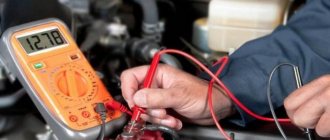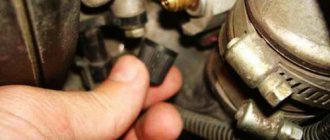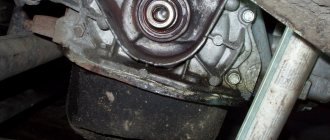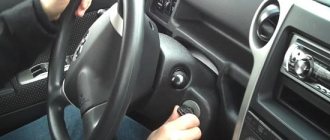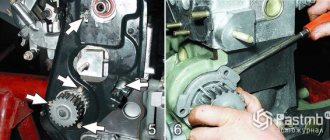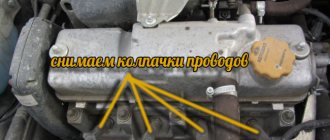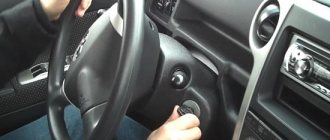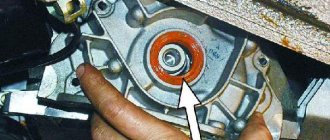The appearance of extraneous sounds after starting a cold engine, as well as during further operation of a warm engine, requires immediate clarification of the reasons. In the engine compartment you may hear engine knocking, whistling of belts and bearings of attachments, crackling or crunching noises, as well as other noises. Such sounds are superimposed on the overall smooth noise of the power unit, differing in strength, frequency and intensity.
We also recommend reading the article about what can knock in the engine. From this article you will learn how to determine the malfunction of various internal combustion engine components by the nature of the knock.
Whistling noise in a V-belt drive is usually caused by friction. A whistling sound appears due to the loss of one or two contacting surfaces of their properties. We add that belts, bearings and pulleys are influenced by the humidity of the outside air, temperature, degree of wear and damage, the amount of lubricant in the bearings, the quality of the belt drive adjustment and other factors. Next we will talk about what can most often make a whistle under the hood when starting the engine.
Debugg
Once the root causes have been identified, the troubleshooting process can begin directly. We stock up on time and tools. Now that everything is collected, we can begin. It is worth being prepared for the fact that parts will be required.
It is worth noting that for each specific make and model of car, the design features of the repair and location of parts will be different.
Therefore, it is recommended to first review the technological maps and study the design. Moreover, it is best to have a repair manual for the vehicle that will be restored.
Drive belts
Typically, a whistling sound in the engine, especially during a cold start, is associated with belt drives. Thus, a stretched belt slips along the pulley, which creates a characteristic squeak. Often, this effect is characteristic of the timing belt on newer cars. There are two ways to troubleshoot the problem.
The first way is to tighten the belt (only for cars with a belt and a tension pulley). To do this, you will have to dismantle the protective casing that covers the timing belt, and then tighten the drive using a tension roller. Sometimes it happens that the belt is in a very worn condition and requires replacement.
The second way is to replace the belt. Replacing the timing belt is a rather complex and time-consuming task. Therefore, it is recommended to carry out this operation at a professional car service center. Many motorists, unknowingly, when replacing the drive belt, knocked out the valve timing, which subsequently brought with it serious consequences for the power unit, such as major repairs.
For different car manufacturers, the timing of replacing the timing belt will be different, but the average indicator is that the element must be replaced after 40-50 thousand kilometers.
The process of replacing the timing belt is quite simple, but at the same time difficult to complete without knowledge of the design of the vehicle, as well as repair methods. So, let's consider the main provisions for replacing the timing belt:
- To begin with, VTM labels are set. This is necessary in order not to disrupt the valve timing when replacing the belt.
- The camshaft or shafts are fixed on pulleys to prevent rotation. There is a special tool for carrying out this operation, but as practice shows, motorists carry out fixation using improvised methods.
- Next, loosen the belt by unscrewing the tension roller.
- If necessary, on some car models, the crankshaft pulley is removed.
- Remove the belt from the seats.
- Typically, assembly of the unit is carried out in the reverse order. For many American cars, there is a specific sequence for installing the timing belt. Therefore, it is recommended to study the manuals before replacing.
Rollers
Together with the timing belt, the whistling noise may be caused by a worn tension roller. This is because the belt slides over the part, creating a whistling sound. The car rollers are replaced along with the timing belt.
On some cars, the rollers can be replaced without removing the drive belt. It is worth remembering that when changing an element, it is necessary to adjust the tension of the drive belt, because if this is not done, then very soon the whistle will appear again, and the belt will be subject to increased wear.
water pump
Many Lada owners are familiar with the whistling sound that appears after starting the engine when cold and disappears after warming up. This effect was caused by faulty pump parts. In both older and newer car models, the whistling effect can be caused by the water pump.
As with the timing belt, a squealing noise can be caused by a worn water pump belt. On older domestically produced cars, the pump is driven from the crankshaft pulley, while the gas distribution chain operates on a circuit installed directly in the block. For newer cars, the pump is part of the timing belt drive.
The knocking noise occurs when there is no obvious failure of parts
The reasons for this type of knocking are associated with high loads, insufficient oil viscosity, as well as misalignment or jamming of one of the parts. If the engine parts have not yet developed any obvious damage, the unpleasant sound disappears after removing the critical factors. Often, to eliminate knocking, it is enough to check the oil level - an insufficient amount of lubricant quite often provokes deformation of parts that cause knocking.
Conclusion
The causes of whistling in the engine are considered. This effect is usually caused by worn parts. To eliminate the problem, you need to replace one of the elements: belt, tensioner, pump or generator parts. Not all car enthusiasts are able to do the process themselves, so it is recommended to contact a car service center.
An experienced driver can determine the cause of the malfunction and how to eliminate it by the sounds of his car. If the belt whistles when you turn on the air conditioner, then most often the problem is related to the V-belt drive. The article discusses the causes of whistling and methods for eliminating it.
"Quading" tapping
Usually, “fading” knocking sounds coming from under the hood are not so critical. They can appear and disappear over tens of thousands of kilometers without any particular reason or change.
Because when the source of noise is the unit itself, this often indicates a malfunction, defects or natural depreciation of moving parts. For example, about problems in the gas distribution mechanism or in the connecting rod and piston groups. Usually these are very sharp knocks, the intensity of which is directly related to the increase in crankshaft speed. That is, the tapping increases in frequency while pressing the accelerator pedal.
What is the source of the problem?
Most often, a whistle in a belt drive occurs due to friction. This means that the surfaces have lost their original qualities. During operation, the belts, pulleys and bearings of the vehicle are subject to constant load and wear out over time. The following factors influence the quality of components:
- temperature at which the working process takes place;
- ambient air humidity;
- natural wear and tear;
A worn, stretched product is the cause of whistling
- quality of bearing lubrication;
- mechanical damage;
- tension of drive belts.
- check the condition of the belt;
- adjust the belt tension;
- lubricate the tension roller;
- in some models the reason may be the alignment of the pulleys;
- Clean the surface of the strap or replace it if there are traces of oil or antifreeze, which could cause the product to slip.
The reasons why the engine whistles can be different. The problem needs to be solved on a case by case basis.
If a whistle occurs, the following measures must be taken:
The source of the whistle can be not only tension, but also the quality of the part. Sometimes replacing with a new product does not help get rid of the whistling sounds. Therefore, you need to buy only original consumables from well-known manufacturers.
How to eliminate a whistling alternator belt
You can get rid of the generator belt whistling by eliminating the reasons that cause it to slip on the pulleys.
If there are signs of belt slipping, accompanied by an unpleasant whistle, we suggest eliminating it in the following order:
- Stop the engine, open and secure the hood to prevent it from closing spontaneously;
- Carefully inspect the alternator belt without removing it from the car. There should be no tears, protruding threads or other visible damage on its surface. If they are detected, the belt must be replaced with a new one.
- Both the inner and outer sides of the belt must be dry and clean, without traces of dirt, oil and other vehicle technical fluids. The same applies to pulleys.
- Check the degree of belt tension - in most cases, the cause of a whistle from under the hood is precisely the weak tension of the generator belt. We wrote about how to properly check the tension level of the alternator belt here.
For information on the optimal degree of tension of your car's alternator belt, refer to its operating instructions.
- If necessary, adjust the belt tension. A good video instruction for adjusting the alternator belt is at the bottom of this page.
- If all of the above did not help and the alternator belt continues to squeak obnoxiously, then with the engine running and good lighting, carefully inspect the line of pulleys for alignment.
An indirect sign of pulley misalignment is the poly V-belt jumping from track to track and sliding off the pulley.
Pay attention to the linearity of rotation of the pulleys - if any pulley rotates in a figure eight, it will tear and throw off the belt. Most often, pulleys with a rubber damper behave this way, which over time loses elasticity and ceases to perform its functions.
And so, if the generator belt has not stopped whistling, but it is intact, clean, well tensioned, and the pulleys rotate smoothly and smoothly, then you can try to correct the situation using another method:
- Remove the alternator belt and carefully inspect it again for damage and dirt. If the belt is intact, then you need to clean its surface from the inside and outside (you can use gasoline or kerosene); if damage is found, buy a new belt.
- With the generator belt removed, thoroughly clean the pulleys from dirt and dust. This is best done with a wire brush. You can also use gasoline or kerosene.
- Place a clean belt on the clean pulleys and adjust its tension. After this, the whistling of the alternator belt should disappear.
If all of the above did not help and the belt whistle has not gone away, then the problem lies either in the quality of the belt itself or in the equipment that is driven by it: tension rollers, generator, power steering pump, air conditioning compressor, etc. Perhaps the grease in the bearings has simply thickened or they have failed, or perhaps the reason is much more serious, so in this case it would be better to seek help from a car service specialist.
You can try to temporarily eliminate the whistling noise using special auto chemicals, so-called conditioner-tensioners for drive belts. This, of course, will not solve the problem, but the whistling will disappear for a while.
Diagnostics and repair
When turning on a cold engine, a whistling noise may occur, which may be caused by the belt slipping on the pulleys. Until the car is warmed up in the cold season, the lubricant in the bearing is sometimes of such a consistency that the belt cannot turn the pulley and slips. The reason for this may be poor quality lubrication, poorly tensioned strap, or wear. The situation can be corrected by changing the oil, adjusting the belt tension, and replacing it in case of wear.
But first you need to check if the pulley is spinning. There are times when a unit jams, then first of all it needs to be repaired. The cause of the whistling may be wear on the surface of the alternator pulley; in some cars it is in the open state. In models where the alternator pulley is located below the crankshaft pulley, the pulley may jam, especially on SUVs. If a toothed belt is installed, then the reason is the bearing.
Loud chattering sounds
This type of noise is most often produced by foreign objects accidentally falling into attachments or moving parts of the motor. For example: pieces of insulation or plastic, leaves, branches, insects and others. Therefore, sometimes it is enough to look under the hood and pull out objects that accidentally appear there.
If the noise does not disappear, then these sounds may indicate more serious damage. As a rule, they indicate failure or delamination of the pump drive pulleys, power steering, and generator.
Video “Whistling in the engine during cold start”
This video explains the cause of the whistling noise that occurs when starting a cold engine and how to eliminate it.
Almost everyone has heard a nasty squeak in the morning when starting the engine. The time for symphonies usually begins in the fall and continues until late spring. Meanwhile, you don’t have to look for the source of the frightening squeal for long - it is under the hood in the area where the attachments are located. It is often driven by a belt drive, the elements of which can produce extraneous sounds. The defect is not critical, but it is unacceptable to ignore it.
Tension roller
The second potential source of whistling noise when starting a cold engine is the timing belt tensioner pulley. Many motorists save on servicing their cars and buy cheaper spare parts, but saving on a timing kit may well lead to serious problems. A low-quality tension roller can stop whistling at any moment and simply jam, which can lead to belt breakage and engine failure. For this reason, whistling rollers should be immediately replaced with new and high-quality ones, and the belts should be changed along with them.
Why does the belt of additional units whistle when starting the engine when cold: probable reasons
How to make sure
It’s not difficult to guess what to do when the alternator belt squeaks or what to do when it whistles - you need to check the tension. Often the belt structure is weakened due to unqualified assistance or stretching during long-term use. This is the first and simple rule when such a malfunction is detected. By the way, it is only available in the case of recent installation of a new product.
However, not all machines have units connected through a generator. On many cars with a timing chain drive, there may be two belts: one connects the current-generating unit and the cooling system pump to the engine. The second is a power steering pump and an air conditioning compressor with a motor.
The test method involves applying additional load to the belts by using the maximum power of the attachment. The alternator belt may squeal at idle if all electrical appliances are activated at the same time:
- Heated seats.
- Car radio.
- Heated side mirrors and rear window.
- High beam headlights.
- Cabin heater.
Belts
Second on the list of suspects were the timing belts and attachments, as well as the drive bearings of these equipment. Bearings do not last forever, and when they wear out, they often begin to make abnormal sounds. The belts lose their tension and begin to slip, which is why they also begin to “sing.” We opened the hood, listened to the engine running at idle, and found no extra noise. The whistle and jammed gas pedal did not turn on, so the car owner was asked to drive the car to a decent car service center. Professional mechanics assessed the current state of the drives, but this examination did not add clarity to the situation. Everything, from the point of view of specialists, is normal, all engine systems are functioning as expected.
Briefly about the causes and ways to eliminate them
If the belt begins to whistle when starting the car engine when cold, this is evidence that it is slipping. Inspection required. It is worth checking both the cleanliness and absence of cracks, and the tension level. A dirty, oily strap with a cracked working surface must be replaced. Dirt getting on the strap causes rapid wear not only of it, but also of the pulleys.
A clean product with a margin of service life is still suitable - just tighten it up if the system allows it. If this is not the case, then only installing a new one will help. The whistle appeared after a recent replacement - the belt was not tightened. Tightening does not help - either the pulleys are worn out, or the rubber product is not original. In special cases, a skewed tensioner is to blame for the squeak.
Sharp growling sounds in the crankshaft area
The need for engine overhaul may be indicated by sharp growling sounds coming from the crankshaft area. As a rule, they occur when pressing the gas pedal. In cars with a manual transmission, there are often cases of sharp knocking when pressing the clutch pedal. This indicates depreciation of the clutch basket, crankshaft thrust rings, or failure of the engine thrust mounts.
Normal resonance
It turns out that the whistling sound can also be created solely as a result of vibration and resonance of certain components (at high speed). For example, one of the reasons for the whistling sound in BMW was the noise produced by the planetary gears. Moreover, such noise is typical for most cars.
The variety of car models produced is simply amazing, and each of them has its own characteristic features. If you are unable to detect any of the described faults, read car forums dedicated specifically to your model, or seek help from a qualified auto mechanic who knows his business well. There are even mechanics who can diagnose the problem just by listening to the sound of the car!
Author: Sochi Auto Repair
During the operation of a car, situations inevitably arise that alarm the driver. One of these problems is the annoying whistle of a running engine. Why does the engine whistle? The problem is not the most serious, but it prevents the driver from concentrating on the road and distracts him from the process of driving.
Drivers often turn to specialists at service stations with the same complaint - a low, annoying whistle that occurs when the gas pedal is pressed, persists while driving, and then slowly stops after the gas pedal is released, and this cycle is repeated every time the pedal is pressed. . Usually only the driver of the car reacts to this whistle.
Why does the engine whistle?
If a car enthusiast understands at least a little about the material part of his car and feels it, he can fix this problem on his own.
The main signs of a whistling engine sound:
- the whistle starts when the gas pedal is pressed;
- the whistle is very quiet and can be heard in the absence of other sounds in the cabin;
- after releasing the gas pedal, the whistle subsides;
- Usually this sound remains unnoticeable for a long time and “appears” somehow completely suddenly;
- such a whistle is not heard outside the car, and passengers do not notice it at all, since they do not feel the connection between the occurrence of the sound and the pressing of the gas pedal;
- In timbre, this sound resembles a “human” whistle and differs significantly from “squealing”, “howling”, “creaking” and “grinding”.
Why does the engine whistle? First, you need to exclude possible sources of the problem with a similar sound. First of all, problems with the brake pads are eliminated, because their “squealing” occurs when you press the brake pedal (or gas pedal + brake pedal).
All problems with belts located under the hood next to the engine are also eliminated.
Belts are the main source of whistling sounds under the hood, but their tone and intensity are completely different. The belts begin to whistle while the engine is warming up. Their problem is slipping relative to the driving and driven rollers.
The moment you press the gas, the belt comes into unison with the rollers, normal operation begins and the whistling stops. It is simply impossible not to notice the whistle emitted by the belt - it is very loud and annoying. The issue of quiet and monotonous sound is also discussed here.
The third possible source of sound why the engine whistles is rollers and bearings. During operation, these parts wear out a lot and begin to “sound,” but they produce sounds of a different type - low, howling. The rollers and bearings begin to “howl” even at idle speed; after pressing the gas, the sound intensifies, but then subsides.
For an experienced technician, the difference between a “howl” and a “whistle” is obvious, especially if a professional is repairing the machine.
After analyzing all the symptoms and options, eventually a good auto mechanic will realize that the source of the problem is the engine intake system.
Eliminating the causes of a whistling engine sound
If a whistling sound is localized at the intake, it is necessary, firstly, to carry out maintenance on the throttle valve - it must be cleaned.
Constant use of the throttle valve leads to severe contamination of the moving parts and, as a result, to “jamming” in certain positions. Because of this, the air, passing under pressure through the damper, begins to whistle. Sometimes, to eliminate the sound, it is enough to simply rinse the damper thoroughly. However, we must remember that in order to properly clean the throttle assembly, it must be removed and completely disassembled.
This is a useful preventive procedure, but it does not always eliminate the whistling.
Therefore, it is necessary to focus on the next device in the intake system - the PCV valve. It is responsible for recirculating crankcase gases. When the engine is running, the air pressure in the crankcase increases due to the movement of the cylinder pistons and heating of the air. Hot air requires additional outlet, otherwise the high pressure will squeeze the oil through the oil seals and any seals. It is impossible to replace the valve with a regular ventilation hole - this may lead to incorrect formation of the air mixture at the inlet.
To understand why the engine whistles and where the whistle comes from, it is necessary to consider the valve design. The valve body has a piston pressed by a spring on the air outlet side. If the engine is turned off, the valve is closed. When the required crankcase gas pressure is reached on the valve, the spring moves, allowing gases to enter the intake system.
If the spring is contaminated with used oil, the valve stops closing completely. Air begins to flow into the resulting gap, producing a quiet whistle.
When you press the gas pedal, the throttle valve opens and air enters the rarefied atmosphere of the intake manifold. It is the vacuum that causes air to be drawn in and a whistle to appear.
When the PCV valve is completely stuck, oil leaks into the intake manifold. The presence of oil stains is a signal to clean the valve.
Simply cleaning the valve will help get rid of the whistling noise.
A simple method for cleaning the valve:
- remove the valve (located on the valve cover or on the crankcase ventilation tube next to the air filter);
- find out what material the valve is made of. If the valve is metal, then any cleaners (aerosols, liquids, pastes) can be used. The main thing is not to scratch the surface. Cleaning sequence: treat the surface, move the valve. Repeat until complete freedom of movement. To clean the plastic valve, do not use too aggressive liquids (the housing may be damaged);
- After cleaning, put the valve back in place.
As a result, after the measures taken, the whistling should stop. If auto mechanics have checked the brake pads, belts, bearings, rollers, and other mechanisms and confirmed their serviceability, then cleaning the valve will help rid the engine of annoying and irritating whistling.
We found out why the engine whistles, as long as our brains don’t whistle!
Did you like the article? Share with your friends on social networks!
